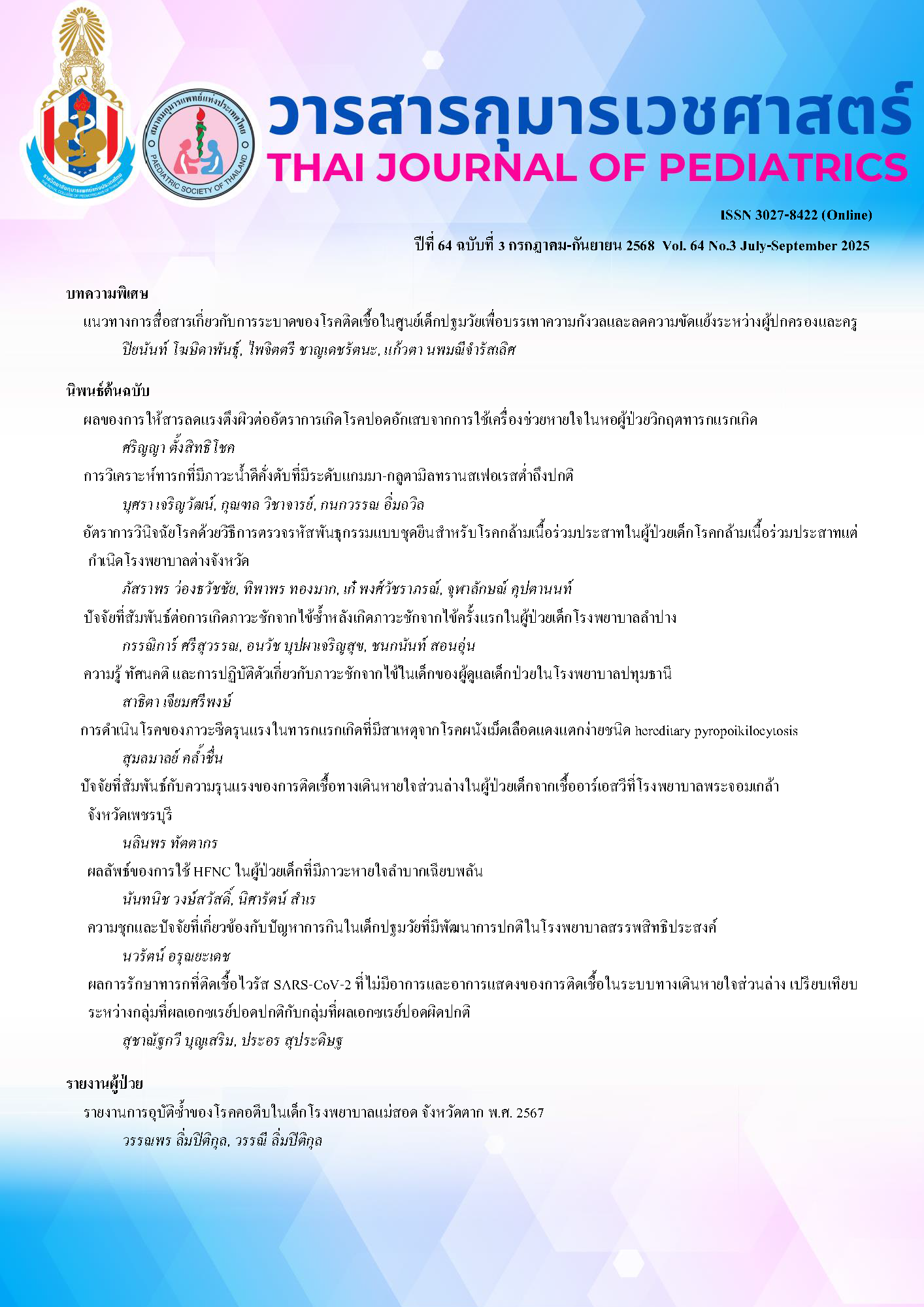Factors associated with recurrent febrile seizures in pediatric patients after first febrile seizure at Lampang Hospital
Keywords:
febrile seizure, factors affecting febrile seizure, complex febrile seizure, recurrent febrile seizureAbstract
Background: Febrile seizure is the most common neurological condition in children. Children experiencing their first febrile seizure have approximately a thirty percent chance of having recurrent febrile seizures. Lampang Hospital encounters a large number of pediatric patients with febrile seizures and recurrent episodes requiring hospital treatment. Therefore, febrile seizures are a significant problem to identify associated risk factors and prevent from their recurrence.
Objective: To study the factors associated with recurrent febrile seizures and the prevalence of recurrent febrile seizures after the first febrile seizure episode in pediatric patients at Lampang Hospital.
Methods: A retrospective cohort study was conducted by reviewing the medical records of pediatric patients diagnosed with first febrile seizure between October 2016 and September 2020.
Results: A total of 331 pediatric patients were diagnosed with first febrile seizure. Of these, 198 were male (59%). The average age of patients at the time of their first febrile seizure was 20.8±10.2 months. Fifty-nine patients (17.8%) experienced a complex febrile seizure in their first episode. A family history of febrile seizures was reported in 24.2%, and a family history of epilepsy in 0.9%. The most common cause of the first febrile seizure was upper respiratory tract infection (39.5%). Recurrent febrile seizures occurred in 80 patients (24.2%). The majority of recurrences (70%) occurred within the first year after the first febrile seizure. Factors associated with recurrent febrile seizures in pediatric patients at Lampang Hospital included age at onset less than 18 months, a history of premature birth, and a family history of febrile seizures. These factors increased the risk of recurrent febrile seizures by 2.05, 2.08, and 1.80 times, respectively, compared to children without these factors.
Conclusion: Factors associated with recurrent febrile seizures after the first febrile seizure in pediatric patients at Lampang Hospital included age at onset less than 18 months, a history of premature birth, and a family history of febrile seizure.
Downloads
References
Steering committee on quality improvement and management, subcommittee on febrile seizures American Academy of Pediatrics. Febrile seizures: Clinical practice guideline for the long-term management of the child with simple febrile seizures. Pediatrics. 2008;121:1281–6.
Shinnar S, Glauser TA. Febrile seizures. J Child Neurol. 2002;17:S44–52.
กรมการแพทย์ สถาบันประสาทวิทยา. แนวทางเวชปฏิบัติการดูแลเด็กที่มีไข้และอาการชัก. ใน: ทินกร ยาดี, บรรณาธิการ. แนวทางเวชปฏิบัติในการรักษาโรคลมชักสำหรับแพทย์ (Clinical Practice Guidelines for Epilepsy). กรุงเทพฯ: ธนาเพรส; 2565. หน้า 103-7.
Berg AT, Shinnar S, Hauser WA, Alemany M, Shapiro ED, Salomon ME, et al. A prospective study of recurrent febrile seizures. N Engl J Med. 1992;327:1122–7.
Canpolat M, Per H, Gumus H, Elmali F, Kumandas S. Investigating the prevalence of febrile convulsion in Kayseri, Turkey: An assessment of the risk factors for recurrence of febrile convulsion and for development of epilepsy. Seizure. 2018;55:36–47.
คณิตา อิสระภักดีรัตน์. ความชุกและปัจจัยเสี่ยงที่มีผลต่อการเกิดภาวะไข้ชักซ้ำหลังจากไข้ชักครั้งแรกในผู้ป่วยเด็ก โรงพยาบาลสวรรค์ประชารักษ์. วารสารวิชาการแพทย์และสาธารณสุข เขตสุขภาพที่ 3. 2565;19:155-67.
Renda R, Yüksel D, Gürer YKY. Evaluation of patients with febrile seizure: Risk factors, recurrence, treatment and prognosis. Pediatr Emer Care. 2020;36:173–7.
สุมิศรา อารีย์วัฒนานนท์. ปัจจัยที่มีผลต่อการเกิดไข้ชักซ้ำในผู้ป่วยเด็กโรคไข้ชักครั้งแรกของโรงพยาบาลหนองคาย. วารสารโรงพยาบาลมหาสารคาม. 2559;13:119-28.
สุรีย์พร ตั้งสกุลวัฒนา. ปัจจัยที่สัมพันธ์กับการเกิดไข้ชักซ้ำและเป็นโรคลมชักในผู้ป่วยเด็กที่มีไข้ชักครั้งแรกของโรงพยาบาลสรรพสิทธิประสงค์. วารสารกุมารเวชศาสตร์. 2567;63:105-17.
Kumar N, Midha T, Rao YK. Risk factors of recurrence of febrile seizures in children in a Tertiary Care Hospital in Kanpur: A one year follow up study. Ann Indian Acad Neurol. 2019;22:31–6.
Indriani A, Risan NA, Nurhayati T. Five years study of recurrent febrile seizure risk factors. Althea Med J. 2017;4:282-5.
Kantamalee W, Katanyuwong K, Orawan Louthrenoo. Clinical characteristics of febrile seizures and risk factors of its recurrence in Chiang Mai University hospital. Neurol Asia. 2017;22:203-8.
Tu YF, Wang LW, Wang ST, Yeh TF, Huang CC. Postnatal steroids and febrile seizure susceptibility in preterm children. Pediatrics. 2016;137:e20153404.
Tosun A, Koturoglu G, Serdaroglu G, Polat M, Kurugol Z, Gokben S, et al. Ratios of nine risk factors in children with recurrent febrile seizures. Pediatr Neurol. 2010;43:177–82.
Kazemi A, Shervin Badv R, Fallah R, Piri A, Tahernia L, Vafaee Shahi M. The first febrile seizure; predisposing factors and recurrence rate. Iran J Child Neurol. 2021;15:69-76.
Civan AB, Ekici A, Havali C, Kiliç N, Bostanci M. Evaluation of the risk factors for recurrence and the development of epilepsy in patients with febrile seizure. Arq Neuropsiquiatr. 2022;80:779–85.
Saghazadeh A, Mastrangelo M, Rezaei N. Genetic background of febrile seizures. Rev Neurosci. 2014;25:129–61.
Kira R, Ishizaki Y, Torisu H, Sanefuji M, Takemoto M, Sakamoto K, et al. Genetic susceptibility to febrile seizures: Case-control association studies. Brain and Development. 2010;32:57–63.
Kriaa NF, Kolsi D, Rabai A, Fakhfakh F, Triki CC. Clinical and genetic aspect of 30 tunisian families with febrile seizures. La Tunisie Médicale [Internet]. 2019 Apr 1 [cited 2025 May 9];97. Available from: https://latunisiemedicale.com/index.php/tunismed/article/view/3538
Mittal R. Recent advances in febrile seizures. Indian J Pediatr. 2014;81:909–16.
Chung S. Febrile seizures. Korean J Pediatr. 2014;57:384.
Downloads
Published
How to Cite
Issue
Section
License
Copyright (c) 2025 The Royal College of Pediatricians Of Thailand

This work is licensed under a Creative Commons Attribution-NonCommercial-NoDerivatives 4.0 International License.



